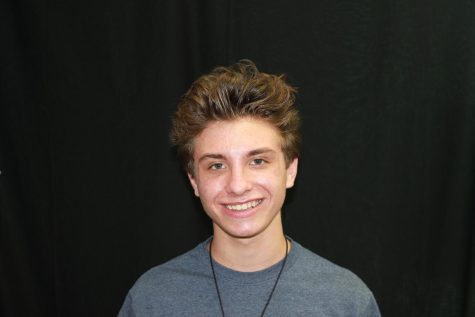Hidden Faces: A look at the school districts approach to mental health
The sound of 1800 students shuffling from class to class is thunderous. The chattering of caffeinated students electrifies the air. It’s just another day at Grand Haven High School. Who would know levels of depression are at an all-time high?
Depression and suicidal thoughts continue to ramp up. But to counteract the rise, GHHS is adding emphasis to mental health safety protocols.
Sophomore Emily, (for purposes of this tough topic we are using a false name to represent her), went through every step in Grand Haven’s tier system. She has been on a roller coaster of a recovery path, experiencing the highs and lows of her journey to a better life.
Grand Haven’s first tier of support: kindling the fire
Like first responders during an emergency, the first line of defense for struggling students are the teachers. Every staff member is QPR certified each year in August before school starts.
What is QPR?
It is suicide prevention training that focuses on referring the person in need to places that can help, and in a building with five school social workers, it has never been easier to aid students to the next step of care.
When a teacher spots a struggling student and starts a dialogue engaging their QPR training, they are required by law to alert other staff members about any abuse, assault, harassment, violent thought, or suicidal thoughts. Teachers are mandatory reporters. Even during conversations in confidence, they are legally obligated to report that information.
Michigan instated the mandatory reporter law to stop problems before they become unfixable, like cases dealing with child abuse, mental health issues, and sexual assault.
Nevertheless, this policy is proven to save lives by connecting students to the help they need.
“The big part of the mental health piece is capturing kids’ hearts,” Spanish teacher Lauren Bloomquist said. “I make sure to build those relationships because you can see kiddos who might need help. I’ve struggled, so I think I put a bigger priority on it, but I mean, I have had over ten students this year answer yes or maybe to the suicide question. I think an important piece is having an open mind so we can build that safe space for everyone.”
The effect teachers have on students is plain to see.
“I went to [one of my teachers] after my suicide attempt,” Emily said. “We were very close, and I trusted her. When I told her what happened, she was like, ‘you’re not okay, and we’re going to get you some help.’ She really helped me. It’s good to find someone you trust.”
Mental health Academy lessons are also part of the first tier of support. They provide healthy coping mechanisms, advice and resources, like numbers to call and text, as well as people they can talk to when they feel depressed or suicidal.
This attempts to ensure that no student is left struggling without a place to reach out. Yes, many confide in their teachers. However, this outlet allows students to connect with mental health professionals directly. In addition, it provides a crisis number to reach out to when students can’t get to a trusted adult, like when they’re alone at night or home from school.
After Emily confided with her teacher, she connected with the high school’s social workers through a mental health portal shared in Academy lessons.
Grand Haven’s second tier of support: building the bridge
Social workers act as damage control for students. Their entire job is to ensure that the high school’s students are mentally healthy through any means necessary, whether it’s crafting the mental health Academy lessons, counseling with students or referring them to mental health resources in the community. In short, their job is to care.
“I am a support role,” social worker Katie Havey said. “I meet with them a couple of times and make some assessments. I use my professional judgment to decide if they need outside help, but in the end, what’s best for the parents, and what’s best for the student is what I go with.”
All five social workers have daily meetings with struggling students, and with the continued high rates of depressive and suicidal thoughts, there’s no sign of that stopping.
According to a survey by the Ottawa County Health Department, suicidal thoughts are up 5.6% since 2011, and depressive thoughts are up a whopping 9.5%.
In 2019 to cope with the rising numbers, GHHS hired three more social workers raising it to the current total of five, and because of this, each social worker can form more personal connections with their students, and it shows.
“[My social worker] was someone I’d go to to talk about whatever I was going through,” Emily said. “I’d email her and say, ‘Hey, can I come down today?’ I told her, ‘I want to get help.’ I’m not usually proud of myself, but I am proud of that moment. I mean, it’s hard to tell someone you want to die.”
But because of the connections the social workers build, many students are able to confide and get the help they need. And the amount of students who do reach out is not a small number. Havey estimates during bad months (October, February and March) she has about four to five referrals a week, which adds up, especially considering the other four social workers.
What is a referral?
It is the process where social workers connect students to mental health resources around the community. In the case of Grand Haven, it’s usually Mosaic counseling. They have a board of 160 therapists across the Ottawa county area.
Mosaic counseling has partnered with the school district since 2011, and they have helped hundreds, if not thousands, of students find therapists free of charge. Their motto is mental health should not be a luxury.
Grand Haven’s third tier of support: intake and rehabilitation
The high school’s approach to mental health is the “broken leg” analogy, as Assistant Principal Mike Roberson put it, meaning if someone hurt themselves at school, the first thing would be immediate treatment from the staff. After that, if it is severe, they would call 911, who would dispatch an ambulance.
If applied to mental health, it looks very familiar. First, a teacher realizes a student is struggling and initiates QPR. From there, the student is sent to their school social worker, who further discusses what’s going on and makes a professional judgment call on the next step. If they find it severe enough, they give them the number to Mosaic Counseling.
The process starts with a phone call or an email to the office. From there, a Mosaic employee will take down why the patient is calling and give them a survey to fill out so Mosaic can better understand their personality and match them with a therapist who would be a good fit.
“Some people say, ‘I’ve tried therapy, and it doesn’t work at all.’ Well, then you probably didn’t have the right person,” Sarah Lewakowski LLP, the Executive Director of Mosaic Counseling, said. “The right person makes a big difference. Therapy is about you. If someone is not a good fit, it’s as simple as trying another. We have a lot of them.”
However, therapy doesn’t mean a quick fix. People who struggle with anxiety and depression often do not see meaningful results in the first couple of sessions. It can take three, four or even longer to see the results, and many patients continually see a therapist for routine maintenance of their mental health.
Emily has been in therapy for the past year.
“It’s not going to heal me,” she said. “I still have those passive thoughts, and I don’t think they’ll ever completely go away. But even at my low points, I know it can get better. The little things help, the smell of fall, my favorite movie, or going places and doing things with people I love. Those moments are so important. [Therapy] has helped so much.”
Lewakowski believes sitting down with a professional can benefit anyone, and that, since Mosaic Cousenling offers 100% free consultation and therapy, why not try?
“Is everything the way you want it right now?” Lewakowski said. “You don’t have to feel this way. This is a place that’ll help. Just try it. Just go once. You do not need to do this alone.”
In the end: Emily’s story
She has come a long way from her last attempt, from the built-up visual trauma of her dad’s death, a long way from six months ago when it all became too much. And Emily still makes it a priority to get better every day.
“You may get to points where you don’t care anymore and fall into that hole, but I promise, there’s always a light at the end of the tunnel,” she said. “If you can’t live for yourself right now, it’s okay. You’ll get there. Don’t let things that happened to you control you. You dictate your life.”
Her road to recovery has been paved with potholes, but she’s more powerful now than ever because of it. She’s living proof that there is always a reason to keep pushing forward.
“I just think of all the things I can experience,” Emily said. “I think of all the people I could meet, all the places I could go, and I know even when I’m at a low point, there are always people who care and people to help you, and that’s what gets me through.”

Riley Vining is ecstatic about joining the Bucs' Blade staff for the first time this year. Riley enjoys reading, whether it is the local news or one of...


Jeanne • Feb 18, 2023 at 7:36 am
From personal experience with my adopted son, a child of profound trauma throughout his early youth, and a GHHS student, we have experienced the caring and concern from teachers and social work staff at the school. The school social worker that my son sees has been of immeasurable help in finding resources for my son, and for me. We are so appreciative.